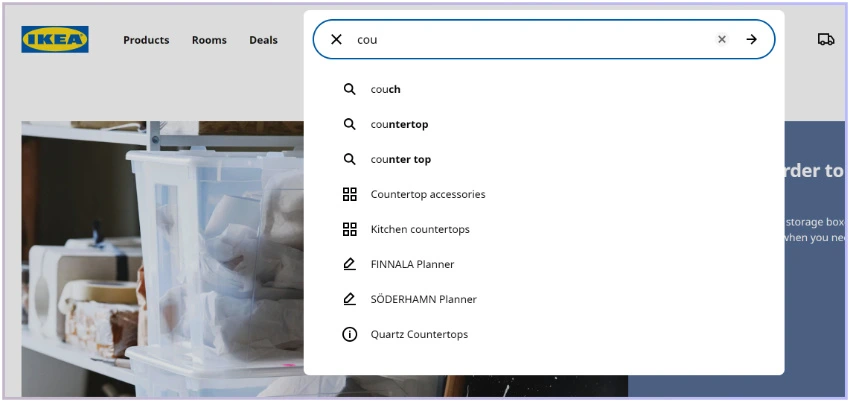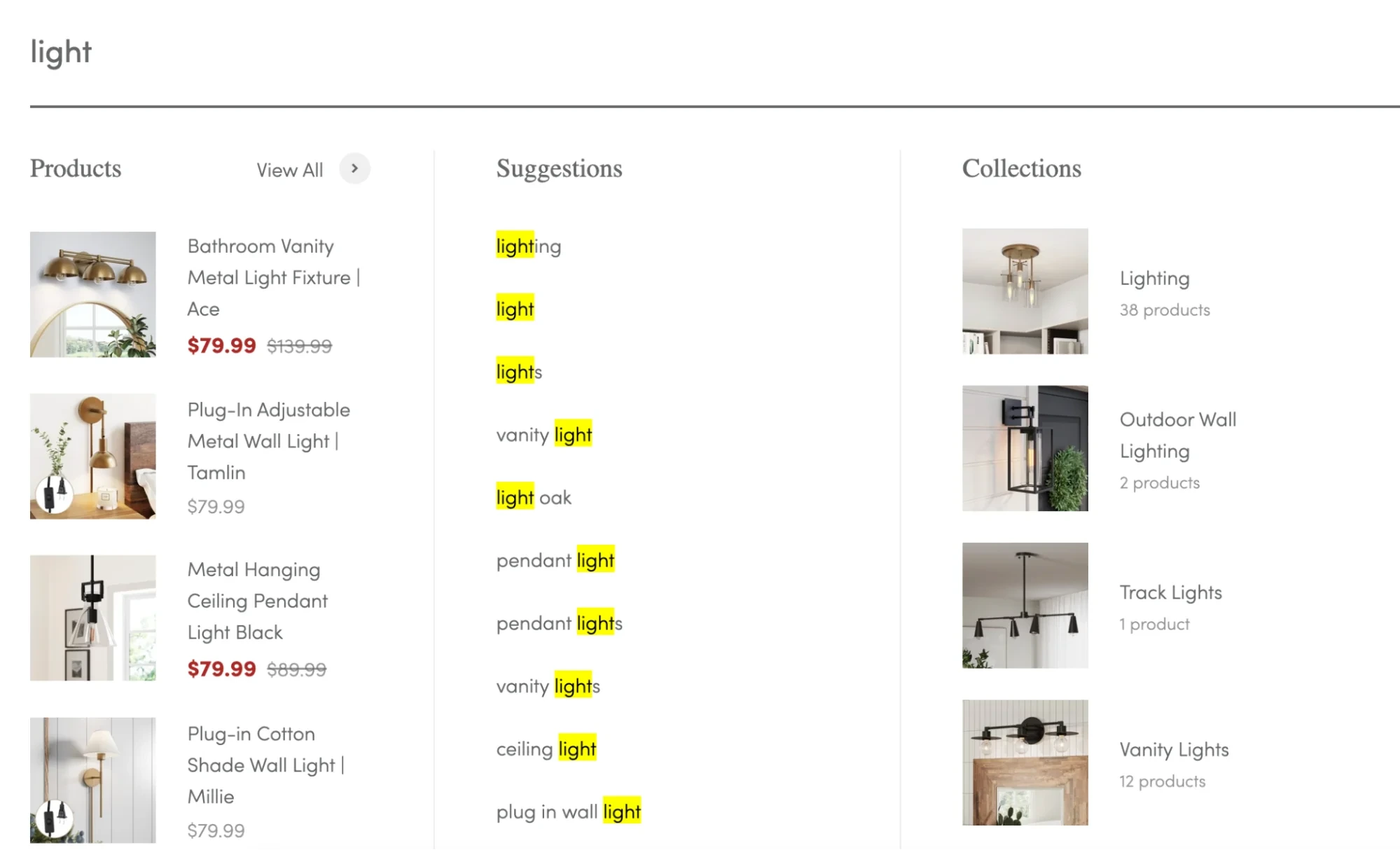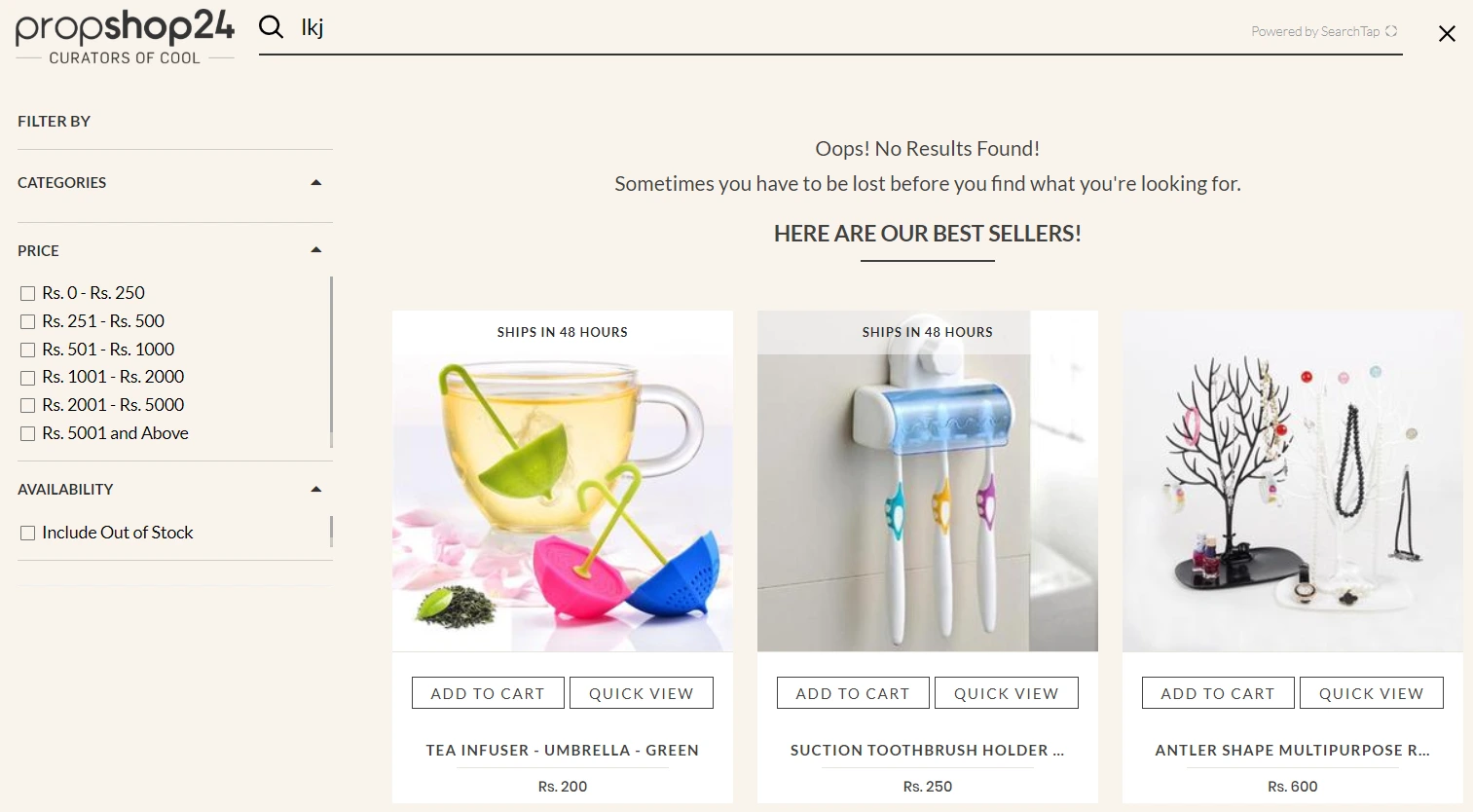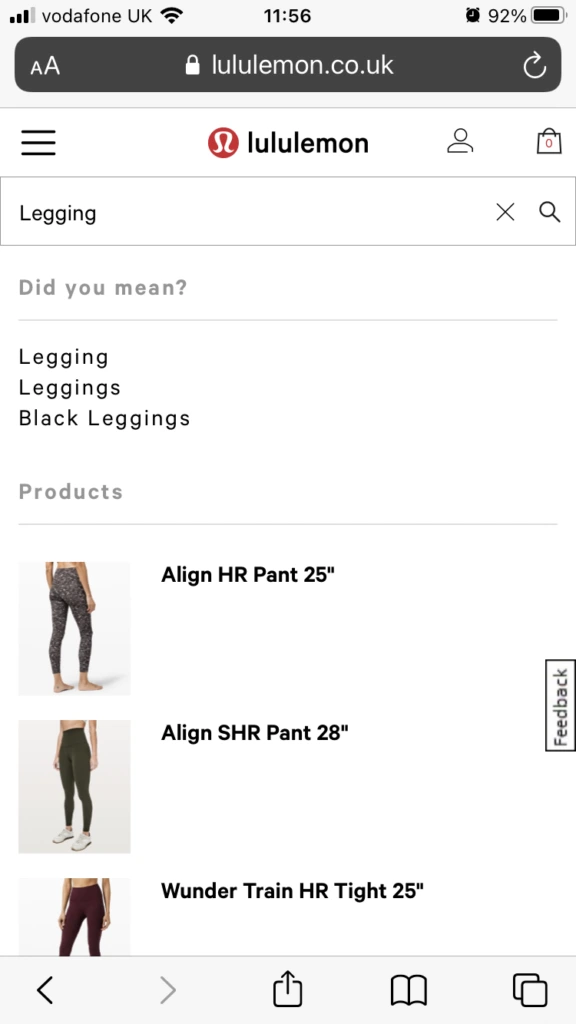Table Of Contents:
A shopper types “ergonomic office chair with lumbar support” into your search bar and hits a dead end. No results. No relevance. Just another lost sale.
In 2025, e-commerce website search will no longer be a backend feature—it will be the front door to conversions. With 43% of users relying on site search first, poor search functionality can sabotage even the best-looking storefront. As on-site search trends evolve, so do expectations.
Whether you’re a global retailer or a niche B2B supplier, intelligent, intuitive, and lightning-fast search is now mission-critical. Customers demand autocomplete search, NLP search that understands conversational queries, and visual search for seamless image-based product discovery. On mobile? Mobile search optimization is non-negotiable. They want personalized search results, voice search optimization, and zero tolerance for “no results found.”
Why E-commerce Search Matters in 2025?
A customer lands on your ecommerce store. What’s the first thing they do?
The majority of shoppers head straight to the search bar.
That tiny box is no longer just a convenience—it’s the core of your e-commerce website search strategy.
In 2025, user expectations have evolved beyond basic keyword matching. Today’s shoppers expect intelligent search solutions that predict intent, handle typos, show visual results, and personalize every query across devices and channels. If your onsite search doesn’t deliver? They’ll bounce—and buy elsewhere.
Search = Conversions, Period.
The math speaks for itself:
- Visitors who use site search are 2–3x more likely to convert than those who don’t.
- 80% uplift in conversions is achievable with personalized search results that reflect browsing behavior and purchase history.
- A single zero-result page can kill the customer journey.
The takeaway? Your search features in 2025 must be built to anticipate, not just respond.
What’s Fueling the Future of Onsite Search?
Emerging onsite search trends are redefining how e-commerce experiences work:
- AI-powered ecommerce search is leveraging deep search intent analysis to predict what users want—even when they’re not sure how to ask.
- Autocomplete search now surfaces results instantly, reducing friction and boosting engagement with predictive search technology.
- Mobile commerce search is built for thumbs, not clicks—making mobile search optimization non-negotiable.
- Conversational search queries are driving demand for NLP search and voice search optimization that mimics natural language.
- Visual search is exploding thanks to tools like Google Lens, with over 20 billion queries monthly as of 2024.
These features aren’t “nice to have.” They’re the new standard.
Supercharge Your Site Search & Product Discovery
Discover how our AI can transform your product discovery and boost conversions.
Top 10 E-commerce Website Search Features for 2025
The future of ecommerce website search is here—and it’s smart, fast, intuitive, and insanely personalized. Whether you run a global marketplace or a niche B2B storefront, your site’s search functionality will either convert users or drive them away. Let’s break down the top 10 search features your e-commerce business needs to stay competitive in 2025.
1. Autocomplete Search: Predict Before They Type
Autocomplete is no longer just a convenience—it’s the first step to conversion. As users begin typing, your site should instantly suggest relevant queries, trending products, and category matches.
This feature reduces friction, guides user intent, and delivers faster queries with reduced typing, ultimately improving the site search user experience and ecommerce conversion optimization.
Pro Tip: Combine predictive search technology with ecommerce analytics to surface personalized autocomplete suggestions based on past behavior or real-time trends.
2. Natural Language Processing (NLP) Search: Understand Conversations
Gone are the days of robotic keywords. In 2025, shoppers expect your NLP search to understand questions like “waterproof hiking boots under $100”, “refill for office coffee machine”, or “cream quilt cover.”
Powered by machine learning in search, NLP interprets conversational search queries to return accurate, contextual results.
Why it matters: NLP enhances zero-result page prevention, boosts search intent analysis, and aligns with Google’s E-commerce SEO trends 2025.
3. Visual Search: Let Images Do the Talking
Image-based product discovery is skyrocketing. With platforms like Google Lens processing over 20 billion queries monthly, visual search is no longer a futuristic perk—it’s a search feature for 2025 you can’t afford to skip.
Users can snap or upload a photo to find visually similar products, even without knowing what it’s called.
Ideal for: Fashion, home décor, auto parts, or any product where looks matter. Visual search = mobile commerce search meets millennial and Gen Z expectations.
4. Mobile Search Optimization: Search That Fits in Your Palm
Your mobile search optimization strategy should deliver a fast, responsive, and intuitive experience on every screen size. In 2025, mobile-first design is the default, not an afterthought.
Key components:
- Voice-enabled search
- Thumb-friendly filters
- Sticky search bars
- Lightning-fast loading
Optimizing for mobile enhances the user-centric search design and reduces bounce rates from frustrated mobile users.
5. Personalized Search Results: Tailored Just for Them
Your customers don’t want to browse—they want to be understood. By leveraging browsing history, purchase behavior, and cart activity, your personalized search results can surface products that feel handpicked.
Think: “Your Style,” “You Might Like,” or “Frequently Bought Together.”
The result? Higher engagement, bigger AOV, and smarter ecommerce conversion optimization.
6. Voice Search Integration: Speak. Find. Buy.
With smart speakers and mobile assistants dominating homes and pockets, voice search optimization is now essential for smart search ecommerce. Shoppers are speaking longer, more natural queries like “What’s the best eco-friendly dish soap under $10?”
Make sure your search engine handles long-tail, conversational queries with ease—and aligns content with AI-powered ecommerce search patterns.
7. Synonym Recognition & Error Tolerance: Smart Misspell Management
Your users aren’t copywriters. They’ll type “sleepsuif” and still expect you to know they meant sleepsuit.
Robust synonym recognition search and error-tolerant algorithms help prevent the dreaded zero-results page. This intelligent layer of ecommerce search best practices ensures you never lose a shopper to a typo.
8. Advanced Filters & Sorting Options: Let Users Refine Like a Pro
The more complex your catalog, the more important advanced ecommerce search filters become. Allow users to filter by price, size, color, stock availability, customer rating, and more.
Bonus: Add sorting options like “Most Popular,” “New Arrivals,” or “Sale Items” to align with real-time buying intent.
A refined onsite search trend that improves both UX and your bottom line.
9. AI-Driven Search Intent Analysis: What They Really Want
Your search engine should do more than match words—it should understand purpose. By analyzing click patterns, search phrasing, and engagement metrics, AI-powered ecommerce search engines can adjust results dynamically to meet the shopper’s underlying goal.
This isn’t just smart—it’s predictive.
Intent-based personalization drives dynamic search results, lowers bounce rates, and turns window shoppers into loyal customers.
10. Dynamic Thumbnails & Price Previews: Instant Product Insight
Search results should sell, not just show. Embedding dynamic thumbnails, real-time pricing, and stock status into search previews creates a frictionless path to purchase.
When users can compare options on the fly, they stay longer, click faster, and spend more. This micro-UX detail supports accessibility in ecommerce search and creates an omnichannel search experience that users love.
How These Features Impact SEO and Conversions
E-commerce website search is no longer just a utility—it’s a revenue-driving powerhouse. In 2025, onsite search is becoming the most underutilized asset in your digital marketing and SEO strategy. Why? Because smart search isn’t just about showing results—it’s about understanding what the shopper truly wants, and delivering it faster than their expectations.
Dwell Time, Bounce Rate & SEO: The Hidden Impact of Onsite Search
Search activity is one of the strongest engagement signals on your site. When users find exactly what they’re looking for—quickly—they stay longer, explore deeper, and bounce less. That’s SEO gold.
- Sites with advanced AI-powered ecommerce search report up to 30% higher dwell time compared to basic keyword-based search systems.
- A smooth mobile commerce search experience slashes bounce rates on mobile devices, especially important with over 60% of ecommerce traffic now coming from smartphones.
- Features like autocomplete search, synonym recognition, and zero-result page prevention keep users on-site and actively browsing, rather than hitting the back button.
Search features are a direct pipeline to user satisfaction. And guess what? Google notices. Improved dwell time, reduced bounce rates, and dynamic engagement contribute to higher search engine rankings, a crucial factor in ecommerce SEO trends in 2025.
Aligning with Google’s E-E-A-T with Smart Search
Google’s E-E-A-T guidelines (Experience, Expertise, Authoritativeness, and Trustworthiness) are changing the e-commerce SEO playbook—and your search experience is now a big player.
Here’s how intelligent search solutions align with E-E-A-T principles:
- NLP search and voice search optimization enable conversational, context-aware interactions, showing users you understand their intent and behavior—a signal of experience and trust.
- Personalized search results demonstrate expertise by delivering tailored content that reflects user history and preferences.
- AI-powered ecommerce search systems support authoritativeness by pushing relevant, high-quality products forward, especially when paired with user reviews and content-rich results.
- Dynamic search results, such as real-time thumbnails and pricing previews, elevate the trust factor by keeping information transparent and current.
The result? A search experience that feels less like a filter and more like a conversation. And that builds credibility—both with users and search engines.
Case Study Spotlight: Inyouths — A Mirror Brand That Reflected Big Returns with Autocomplete Search
When Inyouths, a fast-growing D2C brand specializing in customizable mirrors, realized users were bouncing off their site during product discovery, they decided to revamp the most underrated tool on their website: onsite search.
Their team knew that shoppers landing on a site with a specific product in mind don’t want to scroll—they want results—fast. So, they implemented a smarter autocomplete search experience powered by AI-powered e-commerce search logic and predictive search technology.
The Outcome?
In just three months, Inyouths saw:
- 17% increase in conversion rates
- 28% decrease in search-related bounce rates
- 22% more product page views per session
The upgrade didn’t just make their search bar faster. It made it smarter—with NLP-driven suggestions, visual cues, and real-time thumbnails that matched user intent, even with misspellings or vague terms.
What Changed?
Before the revamp:
- Users struggled to find niche mirror styles.
- Typos or vague searches led to zero-result pages.
- Engagement dropped off after failed queries.
After the upgrade:
- Users received real-time suggestions based on popular search queries.
- Synonym recognition turned “oval” into “round” or “arched” where relevant.
- Search began to auto-populate results with dynamic thumbnails and prices, boosting product clicks instantly.
This aligns with a larger onsite search trend in 2025—using intelligent search solutions that predict needs and reduce effort.
Uncover Hidden Gaps in Your Search and Product Filters
Get a free product discovery audit and find opportunities to improve conversions.
Best Practices for Implementing Ecommerce Search Features
By now, you know the top 10 ecommerce website search features for 2025—like autocomplete, NLP search, visual search, and more. But knowing isn’t enough—implementation is everything. Whether you’re a fast-growing B2C brand, a global B2B store, or a retail giant, here’s how to execute these ecommerce search best practices with precision, purpose, and performance in mind.
1. Choosing the Right Search Provider: Don’t Just Search—Strategize
The market is crowded with AI-powered ecommerce search solutions promising “smart” results. But not all are created equal.
Here’s what you should look for:
- Real-time AI + ML: Look for a provider that supports predictive search technology, search intent analysis, and machine learning in search to deliver intelligent, dynamic results.
- Zero-result page prevention: Ensure your solution uses synonym recognition search, autocorrect, and fallback suggestions to avoid the dreaded “0 results” page.
- Advanced e-commerce search analytics: You should be able to track what users are searching, clicking, and not finding, to optimize continuously.
Pro Tip: Opt for platforms that support conversational search queries, visual search, and voice search optimization. Future-proof now, thank yourself later.
2. Mobile Optimization & Accessibility: Search That Works for Everyone, Everywhere
With mobile commerce search dominating the landscape in 2025, there’s no excuse for poor mobile UX.
Here’s how to stay ahead of onsite search trends:
- Mobile-first indexing means your search interface must be mobile search optimized—quick load times, thumb-friendly filters, and autocomplete that doesn’t lag.
- Design with accessibility in ecommerce search in mind: use ARIA labels, proper contrast, and screen-reader support to make your user-centric search design inclusive.
- Ensure your ecommerce search filters and sorting options are just as usable on a 5-inch screen as they are on a desktop.
3. Balance AI Automation with Human Oversight: Trust the Tech, But Verify the Results
It’s tempting to automate everything, but when it comes to intelligent search solutions, a human touch still matters.
Find the balance:
- Use AI-powered ecommerce search to analyze massive volumes of behavioral data and deliver personalized search results at scale.
- But also regularly audit search outputs—especially in B2B or regulated industries—to ensure relevancy and accuracy.
- Combine AI automation with curated merchandising to push high-margin or high-inventory items, without sacrificing customer experience.
Power Up Your E-commerce Website Search for 2025
In 2025, e-commerce website search isn’t optional—it’s your frontline salesperson. From autocomplete and NLP search to visual discovery and AI-powered intent analysis, these 10 smart features aren’t just trends—they’re must-haves.
They reduce bounce, boost engagement, and drive conversions. Whether you’re B2B, B2C, retail, or enterprise, intelligent search solutions are the secret to staying competitive.
Is your search bar helping customers—or sending them away?
Get a free e-commerce site search audit from ConversionBox and turn missed clicks into conversions.
FAQ:
1. What are the most important ecommerce search features for 2025?
The most critical ecommerce website search features include autocomplete, NLP search, visual search, voice search, personalized search results, AI-powered intent analysis, and mobile search optimization. Together, these features power seamless, intuitive, and relevant product discovery across devices and customer types.
2. How does NLP improve ecommerce search?
Natural Language Processing (NLP) enables smart search ecommerce by interpreting conversational queries like “red shoes under $100” or “office chairs for back pain.” It makes search human-friendly, context-aware, and far more accurate, dramatically improving the site search user experience.
3. Why is visual search important for ecommerce?
Visual search enables image-based product discovery, allowing users to search using images instead of words. This is especially useful in fashion, home décor, and B2B tools, where visuals speak louder than keywords. Platforms with visual search reduce friction and increase conversion rates.
4. How can mobile search optimization increase conversions?
With over 70% of traffic coming from mobile, mobile search optimization ensures users can search effortlessly on any device. Responsive design, voice input, and dynamic loading elevate the mobile commerce search experience—leading to faster product finds and higher conversions.
5. What is personalized search in ecommerce?
Personalized search results use previous browsing behavior, purchase history, and real-time signals to deliver tailored results. This form of user-centric search design increases relevancy, drives more purchases, and boosts ecommerce conversion optimization.
6. How does voice search impact ecommerce SEO?
Voice search optimization involves optimizing your product catalog for natural, spoken queries. It improves long-tail visibility and aligns with Google’s E-E-A-T guidelines, enhancing ecommerce SEO trends 2025. It’s vital for hands-free, mobile-first shopping experiences.
Boost Your eCommerce Conversion Rates with Expert Guidance
Get a free consultation with our conversion specialists to tackle your biggest challenges.








 "Excellent Price and Service Compared to Competition." Paul Cowans, Owner, Cowans Office Supplies
"Excellent Price and Service Compared to Competition." Paul Cowans, Owner, Cowans Office Supplies







